|
How our brain generalize everything ?
Have you ever noticed how a child, after seeing just a few dogs, can recognize a completely new dog they've never seen before and still know it's called a "dog"? Or wondered how we can guess what might happen next based on what we've learned before, even in new situations? How does our brain decide what's important to remember and what to ignore, helping us deal with so many different things around us? The way our brain can learn from specific things and then use that knowledge
in a wide range
of situations is amazing. This skill helps us make sense of the world, adjust to new things, and solve problems very effectively. In this note, we're going to look into how our brains do this. We'll see how our brains learn from everything we see and do every day, and how this helps us understand and handle the world's complexity.
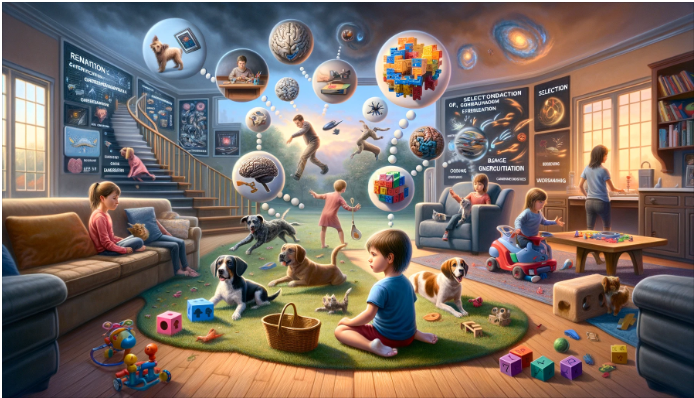
Followings are some of the details I want to look into in this note :
Generalization can occur in various forms, each serving different functions in our understanding and interaction with the world. Each type of generalization plays a crucial role in learning, allowing for more flexible and efficient use of knowledge. Understanding these types helps educators, psychologists, and even artificial intelligence researchers design better teaching methods and learning algorithms that mimic or enhance natural learning processes.

- Learning with Similar Things (Stimulus Generalization)
- Concept: This is about how our brains don't always distinguish between things that are alike. When we learn to react to one thing, our brain often decides that similar things should get the same reaction. This is why experiences that seem alike to us can trigger the same feelings or actions, even if they're not exactly the same.
- Example: If a child is startled by the loud sound of a firecracker, they might also startle at other loud sounds, like thunder or a car horn, because their brain thinks these sounds are close enough to react the same way.
- Using What You Learned in New Ways (Response Generalization)
- Concept: This happens when we take a specific behavior that we've learned in one scenario and apply it to different scenarios. It shows our ability to adapt our learned behaviors to fit new situations, which is crucial for navigating the complexities of daily life.
- Example: A child learns to say "thank you" when someone gives them something at home. Later, they use the same polite response when receiving a gift from a teacher at school, applying their home-learned manners to a new social setting.
- Understanding Words More Broadly (Semantic Generalization)
- Concept: This refers to how we can take the meaning of a word or concept and apply it more broadly to other areas. It's a key part of language learning, allowing us to communicate more effectively by using words in a flexible manner.
- Example: After learning that a rose can be called a "flower," a child later refers to tulips, daisies, and sunflowers also as "flowers," expanding their understanding of the word to include a wide variety of plant life.
- Learning From Consequences (Operant Generalization)
- Concept: This is about learning from the results of our actions and then using what we've learned in situations that are somewhat different but related. It's how we figure out that the outcomes of our behaviors can apply in other contexts, not just the one where we first learned them.
- Example: After a child receives a positive reaction for sharing toys with a sibling, they might try sharing their snacks with a friend at school, hoping to get a similar positive response.
- Grouping Things Together (Conceptual Generalization)
- Concept: This involves recognizing the common features among different items or ideas and understanding them as part of a larger group or category. This cognitive skill helps us make sense of the world by organizing our experiences into categories.
- Example: A child plays with various animals toys—dogs, cats, lions, and bears—and learns to categorize them all under "animals" despite their differences, recognizing that they share common characteristics that define them as part of the animal kingdom.
- Telling Things Apart (Discrimination Generalization)
- Concept: This is the process of learning to recognize and respond differently to items or situations that are similar but not identical. It's about noticing the small differences that make each thing unique and understanding that these differences can affect how we should react.
- Example: A child learns to differentiate between hot and cold objects. They know that just because two objects look the same, it doesn't mean they are safe to touch—some might be hot and can burn, while others are cool and safe to handle.
Generalization is not specific to humans; it is a fundamental learning process observed across many species. This ability to generalize enables both humans and animals to adapt to their environments, make predictions, and survive by applying knowledge learned in one context to new, similar situations. While it is not unique to humans, the complexity and scope of generalization in human cognition and language are distinct.
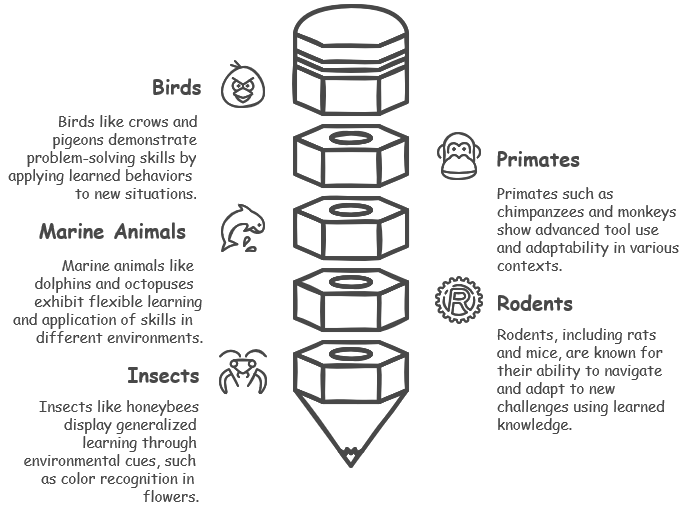
Since we already thought of various types of generalization with focus on human behavior or learning process, now let's look into some examples of generalization shown in Animals. These examples show that many animals can learn something in one situation and use that knowledge in different situations. This helps them find food, stay safe, and solve problems without having to learn everything from scratch every time.
- Birds
- Crows and Ravens: These smart birds learn to use sticks to get food. If they find out one stick works, they try other sticks or objects to do the same thing in new places.
- Pigeons: If pigeons learn to peck at something red to get food, they might also peck at things that are almost red, thinking they might get food too.
- Primates (like monkeys and apes)
- Chimpanzees and Bonobos: If these apes see another ape using a stick to get ants to eat, they might try using a stick to get something else, like honey from a tree.
- Monkeys: Some monkeys use rocks to break open nuts. If they learn this, they might also try breaking something else open with a rock or similar object.
- Marine Animals (animals that live in the ocean)
- Dolphins: Dolphins trained to push a ball for a reward might try pushing other things they find in the water, thinking it might also give them a reward.
- Octopuses: If an octopus learns to open a jar to get to food inside, it might try to open other things it finds, thinking there might be food inside too.
- Rodents (like rats and mice)
- Rats and Mice: If these animals learn how to go through a maze to find food, they can use what they learned to get through a different maze they've never seen before.
- Insects
- Honeybees: Bees look for flowers with nectar. If they learn that flowers of a certain color have nectar, they'll look for more flowers of the same or similar color, thinking they'll find more nectar.
Yes,Generalization is very helpful for both animals and people because it helps them survive and have babies. It lets them learn fast and use what they know in new places or situations. This means they don't need to learn everything from the beginning every time something changes around them. It's like using a key to open many locks, not just one. This skill is great because it helps them quickly adjust to new challenges, find food, avoid danger, and live better in their world.
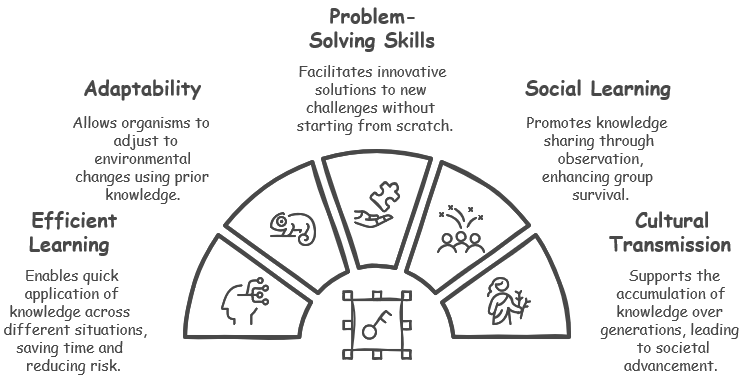
- Learning Fast/Efficient Learning
- Animals and people don't have to see or try everything to learn. They can use a little of what they know in many different ways. This saves time and keeps them safe because they don't have to make risky guesses all the time.
- Getting Used to Changes/Adaptability
- When things change around them, like the weather or where they live, they can quickly adjust. This is because they can use what they've learned before in new situations. This makes it easier for them to find food or stay away from danger.
- Solving New Problems/Problem-solving Skills
- Being able to think of new ways to use old ideas helps animals and people solve tricky problems. They can figure out new ways to get food, build homes, or stay safe without having to learn everything from the start.
- Learning from Others/Social Learning and Cooperation
- Watching and doing what others do, without having to try it themselves, is very useful. It means good tips, like where to find food or how to make tools, can be shared around. This helps everyone in the group do better.
- Dealing with Lots of Things at Once/Navigating Complex Environments
- The world is a busy place with lots of different parts. Animals and people can make it simpler by noticing what's the same and what's different about things. This means they can make smart choices faster, like which places are safe or where to find the best food.
- Passing on Knowledge/Cultural Transmission
- For people, especially, sharing what we know helps us build on old ideas and make new things. It means we get better and smarter as a group, not just one by one. This has helped us make all the stuff we have, like houses, cars, and computers.
Yes, while generalization is a highly beneficial learning mechanism, it also has its pitfalls. These can impact both the accuracy of learning and the way one interacts with the environment.
Generalization helps us learn fast and adapt to new things, but if we're not careful, it can cause problems. Sometimes, we might misunderstand each other, not express ourselves clearly, or be too scared of things we shouldn't be. That's why it's important to check and make sure we're using generalization the right way. We need to know when to use what we've learned in one situation in another, and when to see that situations are different and need different responses.
Imagine it like this: Just as we decide when to wear a coat based on the weather, we should decide how much to use what we learn from one experience in another. It's about finding the right balance. Knowing when to generalize and when to pay attention to the small, unique details can help us understand each other better, make smarter choices, and live better lives. This balance is a skill that helps us not just now, but in the future, making our lives richer and more meaningful.
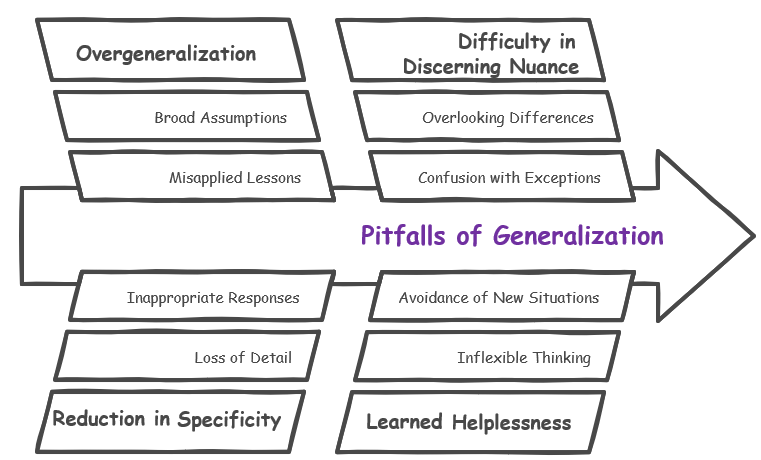
Here are some of the major pitfalls associated with generalization:
- Overgeneralization
- Sometimes, people or animals learn something in one place and then think it's true everywhere, even when it's not. This can make them act in ways that don't really fit the new place or situation.
- Example: A person who got bitten by a small dog might start thinking all dogs are dangerous and avoid them, even the friendly ones.
- Reduction in Specificity
- Sometimes, when we use generalization, we forget to notice the small, special things that make places or things different from each other.
- Example: Imagine learning how to greet people by saying "Hi" and giving a high five. This works great with friends at a playground. But if you do the same thing when meeting someone important for the first time, like a school principal or at a formal event, it might not seem appropriate because each situation has its own rules for how to say hello respectfully.
- Difficulty in Discerning Nuance
- When we use the idea of generalization a lot, it may be hard for us to see and understand the small, important things that make things different.
- Example: If a child learns that all birds fly and then sees a penguin (which doesn't fly), the child might be confused or not understand why the penguin doesn’t behave like other birds.
- Learned Helplessness
- This is when someone thinks that the general rules they’ve learned about something work the same way in every single place or situation. If they face a situation where the rule doesn't work, they might feel unable to make any other choice.
- Example: If a child learns in school that all social media is untrustworthy and is told to keep away from it, they might not engage in healthy online learning events, even when it’s focused on positive social impact, because they generalize all social media activities to be risky.
Yes, generalization involves several specific regions of the brain, each contributing to different aspects of this complex cognitive process. The ability to generalize—taking information from one context and applying it to another—relies on both the integration and coordination of multiple neural systems.
Each part of the brain has a special job that helps us take something we've learned, like how to act or what to expect, and use it when we face something new. This amazing team in our brain helps us deal with lots of things in the world, making us really good at using what we know to figure out things we don't know yet.
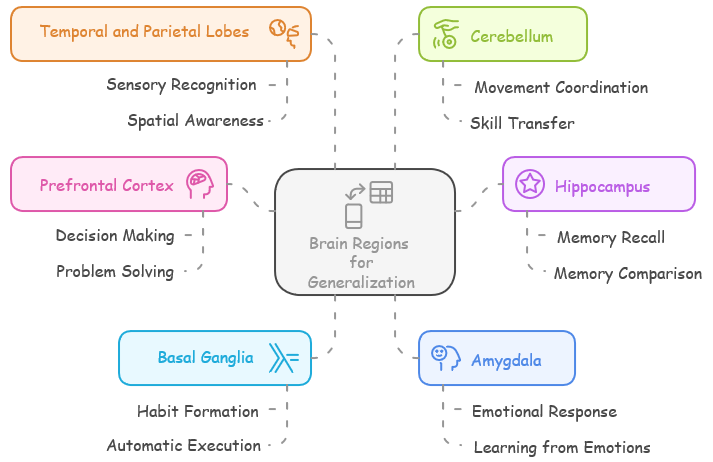
Here are key brain regions involved:
- Prefrontal Cortex/Front Part of the Brain
-
This part of the brain helps us with making decisions, solving problems, and planning ahead. It's like our brain's "thinking cap" that helps us take what we learn in one place and use it in other, new places. Imagine it's like using a lesson from a math class to figure out how to split a bill at a restaurant.
- Hippocampus/Memory Keeper
- Basal Ganglia/Habit Helper
-
This part of the brain helps us make and keep habits, like learning to ride a bike or tying shoelaces. Once you learn how to do something in one place, the basal ganglia help you do it again somewhere else without thinking too hard.
- Amygdala/Feelings Spot
-
The amygdala is mostly in charge of our emotions, like feeling scared or happy. It also helps us learn from emotions. So, if something scared us once, the amygdala can make us feel wary when we're in a new place that feels a little bit like that scary situation.
- Temporal and Parietal Lobes/The Parts for Sensing and Knowing Where We Are
-
These brain spots help us with our senses and understanding where things are in the world. They help us recognize when something we learned about, like the look or shape of an object, shows up in a different place or time.
- Cerebellum/The Brain's "Coordinating Guide"
-
Even though the cerebellum is usually for helping us move smoothly, it also has a hand in learning how to take body movements we know from one situation and do them in new ways. For example, if you've learned to dance, the cerebellum can help you use some of those moves when playing a new sport.
Yes, there are medical conditions that can affect the process of generalization, impacting how individuals learn from experiences and apply that knowledge to new situations.
When someone has trouble with generalization, it means they find it hard to take what they learn in one situation and use it in another. This can make everyday life and learning new things challenging. Doctors and teachers can help by teaching in ways that make it easier to understand and use information in many different situations.
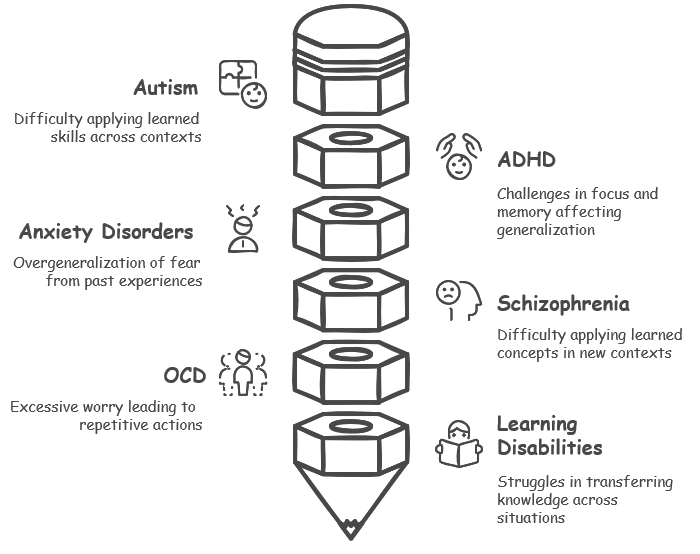
- Autism
- ADHD (Attention Deficit Hyperactivity Disorder)
- Anxiety Disorders
-
In anxiety disorders, people might become too scared of things or situations that are not really dangerous. Their fear from one bad experience might make them scared of many other things that are similar, even if those things are safe.
- Schizophrenia
- OCD (Obsessive-Compulsive Disorder)
-
In OCD, a person might worry too much about certain things, thinking they are dangerous even when they're not. They might feel they have to do certain actions over and over to stop bad things from happening, even in situations where it doesn't make sense.
- Learning Disabilities
Reference
YouTube
|
|






